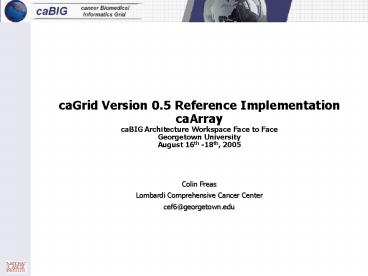caGrid Version 0.5 Reference Implementation caArray caBIG Architecture Workspace Face to Face Georgetown University August 16th -18th, 2005 PowerPoint PPT Presentation
1 / 11
Title: caGrid Version 0.5 Reference Implementation caArray caBIG Architecture Workspace Face to Face Georgetown University August 16th -18th, 2005
1
caGrid Version 0.5 Reference ImplementationcaArra
ycaBIG Architecture Workspace Face to
FaceGeorgetown UniversityAugust 16th -18th,
2005
- Colin Freas
- Lombardi Comprehensive Cancer Center
- cef6_at_georgetown.edu
2
Outline
- High Level Overview of caArray
- Data Model
- Project Architecture
- Process of getting to Silver level compliance
- Functionality Exposed to Grid
- Process of Grid Enablement
- Demo/Screenshots
- Lessons Learned / Technical Difficulties / Wish
List - Acknowledgements
3
Project Overview
- In our context, NCICB's caArray consists of a
microarray database and the associated web-portal
and API for accessing that data. - caArray is a standards based data repository of
microarray experiment data. - The MIAME standard describes the Minimum
Information About a Microarray Experiment that is
needed to enable the interpretation of the
experiment results unambiguously and,
potentially, to reproduce the experiment.
caArray is compliant with the MIAME 1.1 standard. - Concepts within the MIAME standard can be mapped
to the MAGE-OM and to MAGE-ML which are an object
model and an XML format, respectively. This is
the basis for caArrays object model. - caArray consists of two parts a web application
where users input experiment data and perform
searches, and the MAGE-OM server, which allows
programmatic access to caArray objects. API
access is read-only and is achieved via RMI.
4
Data Model
- Experiment - The Experiment is the collection of
all the BioAssays that are related by the
ExperimentDesign. - ArrayDesign - Describes the design of an gene
expression layout. In some cases this might be
virtual and, for instance, represent the output
from analysis software at the composite level
without reporters or features. - BioDataCube The experiment data itself.
- The rest of the is ostensibly required to
duplicate experiment results. This has been an
ongoing challenge for microarray experimenters,
which the MAGE-OM is an effort to address.
5
Project Architecture
6
Process of getting to Silver level compliance
- Programming and Messaging Interface
- RMI based MAGE-OM API and EJB APIs provide
programmatic access to data. - Vocabularies/Terminologies Ontologies
- Utilizes MGED Ontologies and corresponding
vocabularies. - Data Elements
- CDEs defined and entered in caDSR. caCoreToolkit
used to define and semantically map CDEs in
caDSR. - Information Models
- UML class diagram defined and available for
interface.
7
Functionality Exposed to the Grid
- caArray is a data service.
- All objects within the MAGE-OM, which are exposed
via an API are accessible. Important examples
BioDataCube, Experiment, ArrayDesign. - Login and password are required, however public
data from caArray nodes can always be accessed.
8
Process of Grid Enablement
- Standing up caArray locally was no easy task.
Tremendous help was provided by NCICB to work out
bugs in the 1.2 release packages, and by Scott Li
and John Osborne in standing up the MAGE-OM
server. - Standing up local caGrid node easier. Scripts
provided by NCICB installed GLOBUS, OGSADAI,
Tomcat, the caGrid infrastructure, and the
caArray node. - The MAGE-OM server is the interface between the
grid and caArray. - Much work in enabling caArray to function on the
grid had already been accomplished.
9
Demo and/or Screenshots
- Lets go to the videotape!
- Query to caArray public data from Georgetown and
NCICB instances. Private data from Georgetown.
Use Experiment objects. - Query to caArray get gene accession numbers for
a set of genes in the ArrayDesign for the
Affymetrix 133 2.0 microarray. Run query with
accession numbers against caBIO. - Query to caArray Genepix ArrayDesign for IMAGE
Clone annotations. Use returned results to query
caBIO with appropriate Clone characteristics. - Query to caArray data at Georgetown and NCICB
returning an aggregate result set.
10
Lessons Learned / Technical Difficulties / Wish
List
- caArray QC. Version 1.2 had a lot of problems.
It was not possible to install without additional
resources, provided in our case by NCICB and
fellow adopters. It took a month to correct the
files on the public download site. Development
cycle may be too short. - caGrid software made the installation process
very easy, but not necessarily transparent. More
documentation and copious feedback during the
install process would be useful. - Firewall issues. Several ports need to be
correctly configured on both the MAGE-OM server
and on the local grid node. A standard way of
documenting such requirements for caBIG projects
would be nice. - Some way to stress test the system and to collect
performance metrics would be useful.
11
Acknowledgements
- Arnie Miles Georgetown caBIG lead
- Nick Marcou coordinating with caGrid team to
install node. - Jack Yuelin Zhu entering test data and testing
caArray from a users perspective - Colin Freas overall coordination from
Georgetown, setting up local caArray instance - Sumeet Muju Juergen Lorenz indispensable
support in standing up our local instance of
caArray - Andrew Shinohara provided great help in
elucidating test scenarios and writing the XML
for the grid queries - Ruowei Wu Manav Kher providing some excellent
scripts for installation of caGrid node - William Sanchez caGrid team liaison,
coordinating efforts from the NCICB and keeping
the efforts moving forward with a sense of
urgency - Scott Li and John Osborne Scott wrote a
critical script which correctly ran the MAGE-OM
server which caGrid communicates with, and help
in running unit tests against it. John provided
several example configuration files, and some
other critical unit tests.

